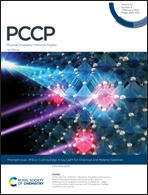Excitons in two-dimensional atomic layer materials from time-dependent density functional theory: mono-layer and bi-layer hexagonal boron nitride and transition-metal dichalcogenides
Abstract
Time-dependent density functional theory (TDDFT) has been applied to the calculation of absorption spectra for two-dimensional atomic layer materials: mono-layer and bi-layer hexagonal boron nitride (h-BN) and mono-layer transition metal dichalcogenides, MoS2 and MoSe2. We reveal that the character of the first bright exciton state of bi-layer h-BN is dependent on the layer stacking type through the use of many-body perturbation theory (MBPT) calculations, i.e., the electron and hole in the AA′ stacking are present in the same layer (an intralayer exciton) while the A′B stacking exhibits an interlayer exciton. We demonstrate that the TDDFT approach with the meta-generalized gradient approximation to the exchange–correlation (XC) potential and the Bootstrap XC kernel can capture the characteristics of the absorption peaks that correspond to these excitons without computationally heavy GW and Bethe–Salpeter equation calculations. We also show that the TDDFT method can capture the qualitative features of the absorption spectra for mono-layer transition metal dichalcogenides, MoS2 and MoSe2, although the exciton binding energies are underestimated. This study elucidates the usefulness of the TDDFT approach for the qualitative investigation of the optical properties of two-dimensional atomic layer materials.



 Please wait while we load your content...
Please wait while we load your content...